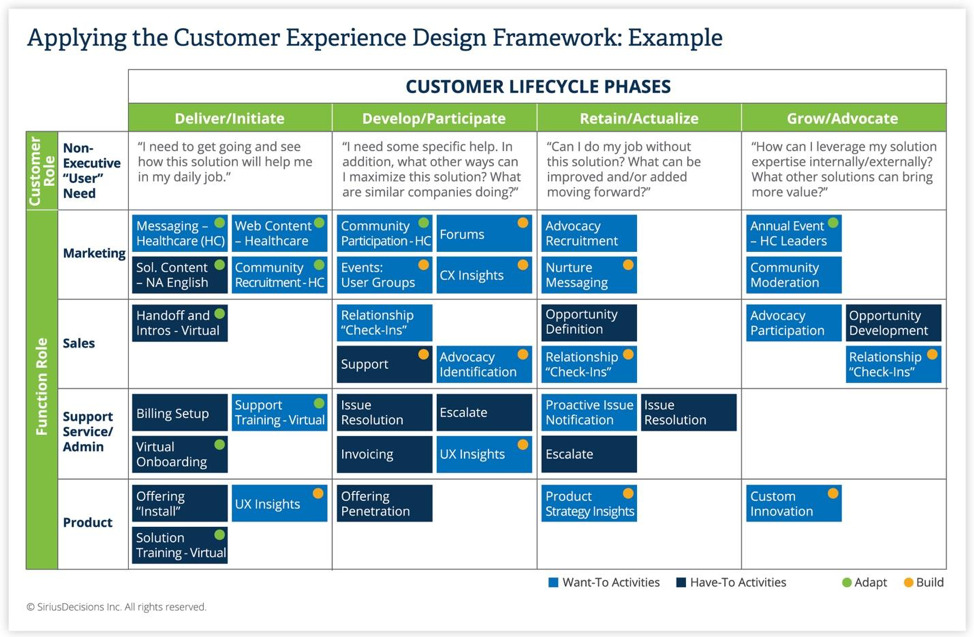Healthcare Spotlight: Improving Customer Experiences with Journey Mapping
- As B2B healthcare organizations move to value-based care and recurring-revenue models, more focus is being placed on post-sale customer experiences
- Driving customer journey improvements cross-functionally requires an understanding of customer persona needs and a process for mapping customer touchpoints by lifecycle phase
- The SiriusDecisions Customer Experience Design Framework provides a structure and process for organizations to improve customer journeys
This is the fifth in a series of blog posts that describe how B2B healthcare leaders are driving results with innovative marketing, sales and product strategies. Although the approach of each blog post may vary, the concept is consistent – examining what’s really working for B2B and B2B2C healthcare leaders today, on the basis of SiriusDecisions clients’ priorities and progress.
A major area of opportunity for B2B healthcare marketing leaders is in understanding and improving post-sale customer engagement. With the increasing prevalence of health IT recurring-revenue business models (e.g. software as a service, platform as a service) and value-based care models, organizations seek to build the business by improving the post-sale experience, in the hopes of increasing customer retention and loyalty. Doing so requires them to understand the current state of customer experience and identify the most impactful improvements that can be made by various customer-facing functions.

To meet these requirements, many organizations are adopting customer journey maps as a foundational tool. Customer journey maps are powerful visual tools that enable fast identification and communication of gaps and opportunities from the customer’s point of view. A journey map should be created for each key customer persona (as customer personas are often different from buyer personas) across each phase of the customer lifecycle. With the major customer personas identified, along with their needs for each phase, the company must then map how each major function – e.g. marketing, sales, support/service, product management, and invoicing/operations – should deliver on those needs.
The SiriusDecisions Customer Lifecycle Framework includes the following phases, which are viewed from the perspective of the company as well as the customer:
- Deliver/initiate.During this phase, the company onboards new customers with tools and training to launch the customer relationship and provide reassurance that promises made during the buying process will be kept. Customers initiate their usage of the company’s products and services and provide feedback.
- Develop/participate. During this phase, the company delivers on its brand promise and instills customer confidence. Customers are actively engaged and begin to incorporate the offering into their business.
- Retain/actualize.During this phase, the company demonstrates that the value it has provided meets or exceeds the customer’s expectations, which earns retention and growth. The customer recognizes and articulates the financial value of the relationship to internal stakeholders.
- Grow/advocate. During this phase, the company seeks to grow the customer relationship through upsell and cross-sell activities, while cultivating customer advocates and nurturing the entire relationship. Key individuals within the customer organization participate as advocates for the company to internal and external audiences.
Customer Journey Mapping: An Example
A compelling example of customer journey mapping benefits occurred at Nuance, a $2.1 billion software firm that provides clinical speech recognition, medical transcription, clinical documentation improvement, coding and diagnostic imaging solutions, helping clinicians focus more time on caring for their patients.
The company wanted to better understand, document and share customer needs by expanding its customer experience tools. Carolyn Galvin, a customer insights principal analyst at Nuance Healthcare, worked cross-functionally with the firm’s lines of business to ensure that customer experience tracking, measurement, and outcomes were more holistic and coordinated. Galvin and her team led Nuance Healthcare’s customer journey mapping initiative to inspire the division to be more customer-centric.
Galvin’s team deployed SiriusDecisions’ Customer Experience Design Framework to expand its knowledge and application of the customer journey mapping process. The framework provided a detailed structure to map 10 customer journeys and identify the required and discretionary activities each function needed to perform to better support customer needs.
As a result of this work, customer experience metrics have improved, and insights obtained from the process have fueled the prioritization of work across product development, sales, marketing, support and administration functions. Customer experience metrics and voice-of-the-customer insights have become standard components of quarterly business reviews.
“Identifying moments of truth in our customer journey was helpful, but the real value has been our ability to use customer journey maps to educate and bring the customer experience to life with our people and teams,” said Galvin.

Journey Mapping and Performance
I have seen many SiriusDecisions clients reap benefits from customer journey mapping. Benchmark data from SiriusDecisions’ Command Center® demonstrates significant customer engagement improvements. For example, organizations that have mapped customer journeys of more than 40 percent of their key customer personas achieved the following levels of performance:
- Forty-nine percent enjoyed customer retention rates of more than 90 percent.
- Twenty-eight percent cross-sell to more than 50 percent of their customer base.
- Thirty-seven percent upsell to more than 50 percent of their customer base.
- Forty percent experienced NPS score improvements of more than 20 percent over the last 18 months.
- Forty-five percent experienced NPS response rate increases of more than 20 percent over the last 18 months.
If you want to reap these kinds of benefits, it might be time for your organization to consider mapping your customers’ journeys to support the creation of exceptional customer experiences.